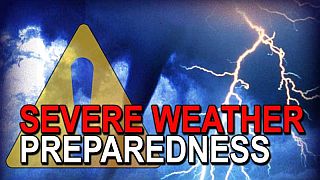 The National Weather Service has reported that Friday afternoon and evening, much of Indiana will face an enhanced or slight risk for severe weather, with a marginal risk for northwestern and southwestern Indiana. The main threats with these storms will be damaging winds, dangerous lightning and a chance of isolated tornadoes. Areas in the northern and southern portions of the state may also see hail.
The National Weather Service has reported that Friday afternoon and evening, much of Indiana will face an enhanced or slight risk for severe weather, with a marginal risk for northwestern and southwestern Indiana. The main threats with these storms will be damaging winds, dangerous lightning and a chance of isolated tornadoes. Areas in the northern and southern portions of the state may also see hail.
Planning and preparation can help keep Hoosiers safe and minimize property damage. The Indiana Department of Homeland Security (IDHS) is encouraging Hoosiers to practice their weather safety action plans, which can help keep families safe in the event of severe weather.
Receive Alerts
Many severe storms occur overnight during normal sleeping hours. As such, it is important to take precautions in advance of severe weather, in the event that immediate action is needed.
- Charge all electronic devices fully before going to bed.
- If devices such as phones and laptops are charging overnight, be sure they are plugged into a surge protector.
- Consider turning up the volume on cell phone notifications. Many smartphones receive alerts for severe weather. Be familiar with the notification settings of weather apps.
- Have an all-hazards weather radio near the bed or sleeping area. Keep the weather radio turned on with a volume loud enough that alerts can be heard while sleeping. Overnight alerts could provide important details about severe weather, with safety precautions to follow.
IDHS also encourages knowing the difference between a watch and a warning. During thunderstorm watches, conditions are favorable for a storm to appear. During a thunderstorm warning, a thunderstorm is already occurring or is about to occur.
Finding Shelter
Finding suitable shelter is another important aspect to preparing for severe weather, such as strong winds or a tornado.
- If living in a mobile home or similar structure, locate a safe shelter in advance.
- For those living in homes or apartment buildings, residents should take shelter in the lowest level of the building, away from windows and doors. Knowing which room or area of the home is the safest during a storm can help keep those in the home out of harm’s way.
Travel Safety
High winds can cause hazards while traveling. High profile vehicles, such as semi trucks, should use caution when traveling through storms. Smaller cars should leave space when following high profile vehicles, as a single strong gust can overturn the vehicle.
When driving in storms, travelers should also know what to do if inclement weather turns into a tornado.
- Take shelter in the nearest building, if possible.
- Do not seek shelter under an overpass. The structure intensifies wind speed.
- If there is no safe building nearby, look for a depression or ditch that is safely and significantly lower than the level of the roadway. Lie down in that area. Hands and arms should be used to protect the head and neck.
- If there is no ditch or low areas nearby, park and stay in the car and continue to wear a seatbelt. Lean over to stay below window level. If possible, use hands, blankets or coats to protect the head and neck.
Power Outages
With weather systems like this, it’s not uncommon to see widespread power outages. While utility companies will be working to quickly repair any outages, storms of this size and magnitude often make it very difficult to restore power immediately.
Take the time before the storm’s arrival to charge cell phones, laptops and other devices, so that if power goes out, electronic devices will have a maximum charge.
Essential supplies to gather ahead of time in case utilities are disrupted:
- Food and water for three days (includes a minimum of one gallon of water per person, per day)
- Battery operated or hand crank all hazards radio
- Flashlight
- Extra batteries for radio and flashlight
- Special items (baby formula, insulin, medications)
To find out more about preparing for severe weather, visit www.GetPrepared.IN.gov.














